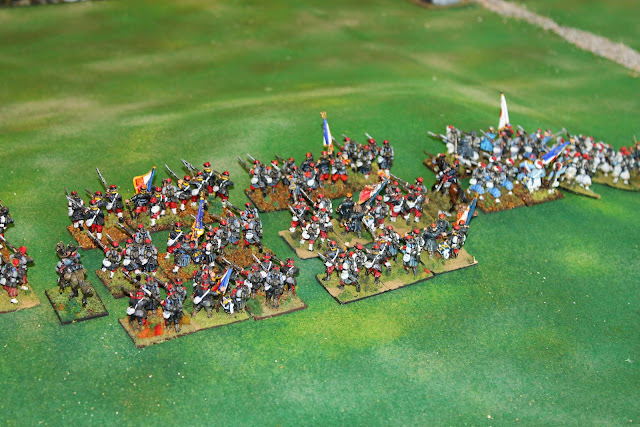Last week we played a Franco-Prussian War game.
The scenario was based very loosely on the battle of Borny. The French were in retreat, preparing to cross a major river, when a Prussian force appeared behind them more rapidly than anticipated. Two French infantry divisions turned back to face Prussian corps.
The objective of the Prussians was to secure the road that led off the table toward the river crossing. The French objecitive was to deny the Prussians control of the road.
The terrain was relatively open with two parallel ridges. Between the ridges was a village.
The French were permitted to deploy 350mm in from the table edge, with the exception of the six batteries of the reserve artillery that had to move onto the table after the first turn. The French chose to deploy on the reverse slope, with a division either side of the road. They chose to bring the reserve artillery on between the divisions, opposite the village.
The Prussians could deploy 300mm in from the table edge. Their divisional artillery could be deployed, but the six batteries of the reserve was in limber. They too chose to deploy either side of the road. The division on the right was to push one brigade through village. The reserve artillery and the cavalry brigade were also assigned here.
The initial Prussian deployment on the right.
The French position to their left, opposite the Prussians show above
For the first turn the French remained concealed behind the ridge, while their reserve artillery arrived on the table. The Prussians, meanwhile, deployed all their artillery while one brigade occupied the village.
The Prussians take the village
On turn two the French reserve artillery rolled into position. At the same time the French divisional artillery came forward to cover the reserve's deployment. This commenced a battle for fire superiority that lasted for the next four turns. At first the French guns held their own against superior numbers, but in the end the numbers began to count and the French batteries were being driven off or destroyed one by one.
With fire superiority achieved the Prussian right hand division prepared to step off. Then a battalion of French chasseurs à pied rushed forward and occupied a small farm on the Prussian flank. The Prussians were compelled to turn three battalions to neutrailise this threat, while the remaining nine battalions advanced.
The Prussian right advances
As the Prussian reached the foot of the ridge, the French pushed to the top of the ridge and opened fire, but failed to halt the Prussian advance. When they attempted to close the French stopped the advance with a second volley then counter attacked and drove back three Prussian battalions. But when the French attepted to push the advance further the Prussian gun mass held them in check.
At that moment the other Prussian division went forward. The brigade on extreme the left was abruptly halted by the French divisional artillery and pushed back, but the right hand brigade, assisted by some battalions from the other Prussian division, forced the French back.
The French right begins to give way
At that moment the Prussians on the right pushed forward again, gaining the flank of the French, driving them back. A large gap was opened in the French centre and the Prussian established themselves in a dominant position astride the road to the bridge. Unable to dislodge the Prussians the French broke off the action.
It was a good game lastng for six hours. It was good to see theses armies out if their boxes, for the first time since November 2012.















